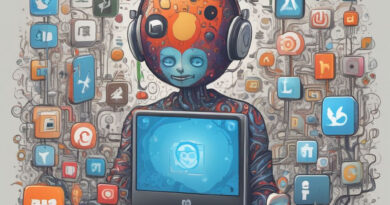🌐 The Future of Virtual Reality (VR) and Its Impact on Social Media

In the world of technology, virtual reality (VR) is rapidly transforming industries, and it’s starting to make waves in the social media space as well. As we move into 2025, VR is expected to revolutionize how we connect, share content, and interact online.
In this post, we’ll explore the future of VR, how it’s already changing social media, and what this means for users and content creators alike.
🕶️ 1. What is Virtual Reality (VR) and Why Does It Matter?
Virtual reality is an immersive technology that uses headsets and controllers to create a simulated environment, allowing users to experience and interact with a virtual world as if it were real. While VR has been around for a while, it’s only in recent years that the technology has become more accessible and mainstream.
By 2025, VR is expected to evolve beyond gaming and entertainment, becoming a staple in social media and communication.
🚀 2. How VR is Changing Social Media Platforms
Social media is all about connecting people, but what happens when you add VR to the equation? In the next few years, platforms like Facebook, Instagram, and Twitter are expected to offer virtual reality experiences that will change the way we interact with content and one another.
Here’s how VR will impact social media:
- Virtual Social Spaces: Platforms like Facebook Horizon allow users to meet in virtual environments and interact in real time, regardless of geographic location.
- Immersive Content Creation: VR will enable content creators to make more immersive and interactive content, from 360-degree videos to virtual tours of real-world locations.
- Live Virtual Events: Think virtual concerts, meetings, and conferences—VR allows users to attend events without ever leaving their homes.
With VR, the distinction between the digital and physical worlds will continue to blur, creating entirely new ways to socialize online.
💬 3. VR and the Evolution of Social Media Interaction
Imagine having a conversation in a virtual room with your friends, colleagues, or even followers. With VR, social media interactions will move beyond text, photos, and videos, offering a truly immersive experience.
As VR becomes more integrated into social media, we can expect:
- Virtual Hangouts: Instead of text chats, you could meet up with friends in a shared virtual space where you can interact as avatars.
- Collaborative Spaces: Businesses and creators can work together in a virtual environment to brainstorm, design, and create content in real time.
- Enhanced Storytelling: Users and brands can share more engaging, interactive stories using VR technology, giving followers a deeper connection to the content.
This level of engagement will redefine online interaction, allowing for more personalized and meaningful relationships in the virtual space.
🎥 4. The Role of VR in Content Creation
Content creators will have more tools at their disposal with the rise of VR. Traditional content, such as photos and videos, will evolve into more interactive experiences that immerse viewers in the story.
Here are some content trends we can expect to see in the future:
- 360-Degree Videos: Social media platforms will support 360-degree video content, allowing users to experience a scene from every angle. Creators can transport their audience to new worlds, events, and experiences.
- Virtual Shopping: VR will change the way we shop online. Users will be able to browse virtual stores and try on products using virtual avatars, making e-commerce more interactive and engaging.
- Virtual Travel: In the future, VR could offer virtual travel experiences, where users can explore destinations without ever leaving their home.
These developments will provide a new dimension to content creation and consumption, leading to increased engagement and more dynamic storytelling.
🧑💻 5. VR and the Future of Digital Advertising
Advertising is set to undergo a major transformation with the integration of VR into social media. Traditional banner ads and sponsored posts will evolve to become immersive advertising experiences that are more engaging and interactive.
How VR will impact digital advertising:
- Virtual Billboards: Just like in physical cities, VR environments may include virtual billboards, allowing brands to place ads in highly visible spots within virtual worlds.
- Interactive Brand Experiences: Instead of simple ad placements, VR will enable brands to create interactive experiences where users can try products in a virtual space.
- Targeted Advertising: With data from VR interactions, brands can tailor their ads to more specific user behaviors and preferences, increasing ad relevance and effectiveness.
As VR technology becomes more widespread, businesses will need to adapt to these new forms of advertising to stay competitive in the virtual world.
💡 6. The Challenges and Limitations of VR in Social Media
While VR offers exciting possibilities, there are some challenges to consider:
- Access and Cost: High-quality VR headsets can still be expensive, and not everyone has access to the technology. This could limit the growth of VR on social media.
- Adoption Rate: For VR to truly transform social media, it will need widespread adoption. This could take time as users become familiar with the technology.
- Content Creation Skills: Creating VR content requires a different skill set than traditional content creation. Creators will need to learn new tools and techniques to create engaging VR experiences.
While these challenges are significant, the potential for VR to reshape social media remains enormous.
🔮 7. What’s Next for VR in Social Media?
As we look toward the future of VR in social media, we can expect the technology to continue evolving in exciting ways. Innovations like haptic feedback (which allows users to feel sensations in the virtual world) and AI-driven avatars will make virtual experiences even more realistic and personalized.
Social media platforms will likely introduce new features and tools to support VR interactions, allowing users to explore virtual worlds, attend live events, and create more engaging content. This will open up new opportunities for social media users and businesses alike.
💬 Final Thoughts: VR is the Future of Social Media Engagement
The integration of virtual reality into social media in 2025 promises to reshape how we interact online, share content, and connect with others. While the technology is still in its early stages, its potential is undeniable.
As a content creator, business owner, or social media user, embracing VR could set you apart and give you an edge in the ever-evolving digital world. Stay ahead of the curve by keeping an eye on VR trends, experimenting with immersive content, and preparing for the future of social media.



